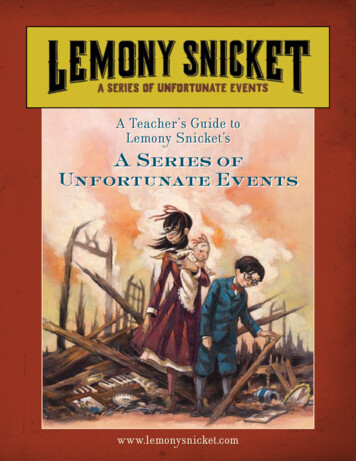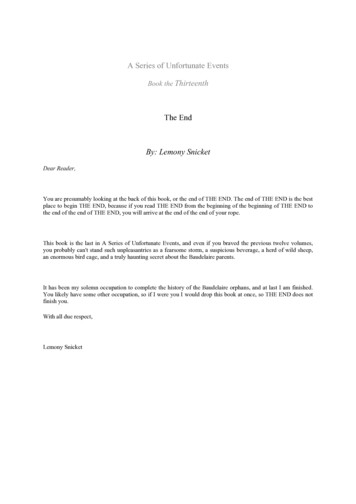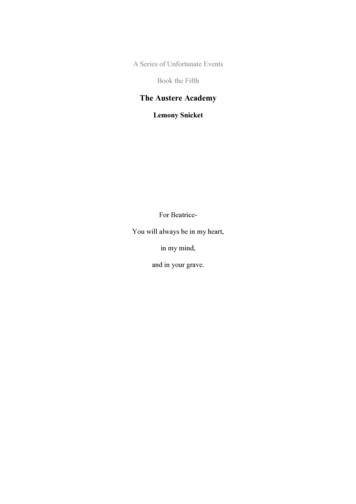
Transcription
A Teacher’s Guide toLemony Snicket’sA Series ofUnfortunate Eventswww.lemonysnicket.com
www.lemonysnicket.com
A Teacher’s Guide toLemony Snicket’sA Series ofUnfortunate EventsDear Educator,Teachers tend to be noble people, because there are few deeds nobler thaninteresting a young person in a good book. Even in the noblest of professions,however, there can be a few bad apples, an expression which here means “teacherswho would rather interest their students in something unpleasant.” The books inA Series of Unfortunate Events, for instance, include man-eating leeches, largevocabulary words, and a talentless vice principal who subjects his students to sixhour violin recitals.In fact, the only thing worse for an impressionable young mind than a book in ASeries of Unfortunate Events is an attractively packaged and inexpensively pricedpaperback book in A Series of Unfortunate Events. Unless you’re a bad apple,you’d be much better off folding this teaching guide into a paper airplane andsailing it straight out your classroom window.Wouldn’t you rather teach something else?With all due respect,www.lemonysnicket.com
About this GuideThe activities in this guide are designed to capitalize on the oddly irresistible genius ofLemony Snicket. In addition to in-depth teaching plans for the first book of the series,The Bad Beginning, you will find extensive across-the-series activities that incorporatethe details of Books 2 through 13. Activities can be used for independent readers,small groups, or full classes.Whether used in their entirety or in part, these activities willallow students to become more adept in understanding vocabulary, idioms, anagrams,word choice, character development, and thematic statements. This guide is meant tosupplement and enhance the teaching of A Series of Unfortunate Events and to createa classroom environment that would impress Mr. Snicket himself.About this SeriesWhen the Baudelaire parents perish in a terrible fire, Mr. Poe, a banker and friend of thefamily, assumes responsibility for the Baudelaire orphans and their fortune. Complyingwith instructions in their parents’ will, Mr. Poe places the children—Violet, a creativeinventor at age 14, Klaus, an avid reader at age 12, and Sunny, a baby with a uniquevocabulary and four very sharp teeth—with their nearest distant relative, Count Olaf,an actor who is determined to steal their fortune. Count Olaf relentlessly pursues thechildren from one guardian to another, hatching a series of ever-more-diabolical plots.The result is a series of misadventures in which the three children can save themselvesonly by out-thinking the treacherous villain and his associates.The Baudelaire orphans’ lives become even more complex when they befriend theQuagmire triplets, whose parents also died in a fire, and the children learn that a secretorganization known as V.F.D. is somehow intricately involved in their past, present,and future. The orphans’ pursuit to discover what V.F.D. is and how their parents wereconnected to it proves difficult and dangerous, but with every misadventure they hopeto arrive one step closer to the truth.Those hoping to learn more about Lemony Snicket and his role in A Series ofUnfortunate Events can consult Lemony Snicket: The Unauthorized Autobiographyand/or the startling private correspondence collected in The Beatrice Letters. www.lemonysnicket.com
An In-Depth Study ofA Series of Unfortunate EventsBook 1: The Bad BeginningAbout the BookDiscussion QuestionsAfter learning of their parents’ death ina terrible fire, Violet, Klaus, and SunnyBaudelaire are taken to live with CountOlaf, a bad actor and despicable villain. TheBaudelaire parents left behind a vast fortune,and Count Olaf plans on taking control of thechildren’s inheritance by tricking Violet intomarrying him. When the children discoverhis plan, Count Olaf kidnaps Sunny, intendingto hold her hostage until the mockery of awedding takes place. Fortunately for Violet,she devises a plan to foil his scheme just intime to save Sunny and their fortune.1. Why does Lemony Snicket warn readers at thebeginning and several times throughout thebook to put it down and read something else?Why would anyone want to read a book whenthey have been forewarned that the likeablemain characters will meet nothing but despair?Are Snicket’s warnings sincere? What effect dothey have?2. Mr. Poe and Justice Strauss do not believe thechildren’s accounts of Count Olaf’s mistreatment.Why not? How might the Baudelaire childrenhave convinced them of Count Olaf’s cruelty?How could the adults have helped the children?3. The children soon realize that they must dependon one another and their own wits in order tosurvive in Count Olaf’s care. How are each of theirspecial skills crucial to their survival?4. The morning after they visit Mr. Poe at thebank, Count Olaf serves the children oatmealwith fresh raspberries. Why is he suddenly sokind to them?5. Count Olaf and his troupe are all actors. How doesbeing actors help them in their villainous plots?6. The Baudelaires are often the victims of bad luck.What could they do to change their situation?7. Who is Lemony Snicket? How does he know somuch about the Baudelaire children?8. Who is Al Funcoot? What did he write?
Vocabulary Activities—Book 1Below is a selection of vocabulary words from each chapter of The Bad Beginning. Use one orall of the following three vocabulary activities in conjunction with this list of words.Chapter 2Chapter 7Chapter 10Chapter 12 Incentive Despondent Nefarious Accomplice Pandemonium Insipid DurationChapter 11Chapter 13 TreacheryRecuperateGrotesqueBrisklySolemnlyChapter 3 AbominablyChapter 8 DilemmaChapter 9 Skulk RelinquishedChapter 5 Invigorated1. Challenge students to write haiku, limerick, and/or diamante poems using any of the vocabularywords as the title and focus of the poem.2. Ask students to define the vocabulary words ona 3" x 5" note card. Then have students workin small groups to prepare a demonstration foreach of the words. Have the small groups presenttheir demonstrations and allow the class to guesstheir words. ScurryHoistedIllegiblePredicament3. Ask students to identify the part of speech foreach of the vocabulary words and categorize themaccordingly. Have students work with partnersor in small groups to write sentences using theirvocabulary word and additional words thatbegin with the same letter (alliteration). Practicereading the tongue-twister sentences and sharethem with the class.
Journal Promp ts—Book 1All is not gloomy with the Baudelaire children—they enjoy themselves at Briny Beach before Mr.Poe’s arrival, they pass the time relaxing andreading books from Justice Strauss’s library, andthey enjoy one another’s company. Write abouta difficult situation that was made better bythe people you were with or by what you weredoing. What happened? How did others help youadjust? How did your activity help make you feeldifferently?Lemony Snicket says, “Unless you have been very,very lucky, you have undoubtedly experiencedevents in your life that have made you cry. Sounless you have been very, very lucky, you knowthat a good, long session of weeping can oftenmake you feel better, even if your circumstanceshave not changed one bit.” Write about a timewhen crying made you feel better. Why do youthink crying helped?Mrs. Poe bought horrible, itchy clothes for theBaudelaire children to wear, and they hatedwearing them. Write about a time that you hadto wear clothing you did not like or that wasuncomfortable. While you were suffering, wheredid you go and what did you do in those clothes?Which was worse—the event or the clothes?Even though Violet and Klaus cooked him and histroupe a delicious meal, Count Olaf was angrybecause he wanted roast beef. Write about a timeyou did something nice for someone else, but itdidn’t result in the reaction you expected. Whatwent wrong? How did you feel? How do you wishthe other person had acted?Research/Writing Activities—Book 1Ask students to assume the role of one of themajor characters and to keep a journal duringthe course of the story recording the character’sfeelings and emotions as each major event unfolds.Students may also include artwork to illustratetheir journal.Have students form small groups and ask themto go to their school or public library and perusethe collection of cookbooks. Ask each group toplan a three-course meal for Count Olaf and hisacting troupe. Course one should be an appetizer,soup, or salad; course two should be a main dish,including meat and vegetables; and course threeshould be a dessert. Ask students to make anillustrated menu.Using The Marvelous Marriage as a model, askeach group of three to five students to select asituation in The Bad Beginning and write a shortone-act play about it. For example, students canselect the scene when the children meet CountOlaf for the first time or the scene with CountOlaf’s dinner with his troupe, or any other scenewith multiple characters. Students should writethe script, cast the characters, and then, afterpracticing and gathering costumes, present theirplay to the class.Brett Helquist illustrates The Bad Beginning,but as with any book, not every scene can bepictured. Ask each student to illustrate (with anoriginal drawing or pictures from the Internetor magazines) a place, a character, or an eventfrom the novel that was not illustrated by BrettHelquist. Students should add an appropriatecaption under each illustration. Display theillustrations in the classroom.Mr. Poe invites the Baudelaires to contact himat the bank if they have any questions, buthe refuses to help when they visit him. Invitestudents to write a formal letter to Mr. Poeat Mulctuary Money Management, informinghim of the situation at Count Olaf’s house andtrying to convince him to take action to help theBaudelaires. Letters may be posted together onthe classroom bulletin board.
Across the SeriesBooks 2 through 13Discussion Questions1. Violet says that everyone should keep a fewsecrets, and almost every character in A Seriesof Unfortunate Events keeps secrets. Whatare the disadvantages of keeping secrets?How can keeping secrets be a good thing?2. A Series of Unfortunate Events takes placeover an unspecified time period. During thecourse of events, in what ways does each ofthe Baudelaire children change? What are themost important lessons they learn?3. In The Vile Village (Book 7), Lemony Snicket’sbrother, Jacques, appears; at the end of TheSlippery Slope (Book 10), his sister, Kit Snicket,comes on the scene. How does LemonySnicket’s role in the story change as the seriesgoes on? What do you think his relationshipto the Baudelaire siblings is? Why is it Mr.Snicket’s “solemn obligation” to tell their tale?4. Many of the Baudelaire’s guardians sufferfrom a “fatal flaw” that makes them unhelpful,no matter how well-meaning they are. Forinstance, Aunt Josephine’s fear of almosteverything prevents her from taking propercare of the children. What are the fatal flawsof some of the Baudelaires’ other guardians?How do their fatal flaws endanger the guardian,the children, or both?5. The Baudelaire children and the Quagmiretriplets realize that they are sending signals,breaking codes, discovering secrets, andwearing disguises, all the things the V.F.D.volunteers do. What role did their parentsplay in training them? Would their parentsbe proud of them? Why or why not? 6. The Baudelaire orphans are betrayed orneglected by many of the people they trust,and mistreated by many of the villainsthey fear. How do Violet, Klaus, and Sunnydistinguish the “good” people from the “bad”people when both have hurt them? How doesthe behavior of the volunteers ultimatelyaffect the decisions the children make?7. What villainous acts do Violet, Klaus, andSunny commit? How do their crimes affectwhat others think about them? How do theseacts affect how they feel about themselves?8. In The Wide Window, Lemony Snicket writes,“If you are allergic to a thing, it is best not toput that thing in your mouth, particularly ifthe thing is cats.” What role does humor playin Lemony Snicket’s writing? Do you thinkhe’s ever kidding? Can something be funnyand sad at the same time?9. Is all of the orphans’ misfortune Count Olaf’sfault? Why or why not?10. Who is Beatrice and what connection doesshe have to the Baudelaire orphans? Whydid Lemony Snicket dedicate the books toher? Why is she an important character inthe series?
Across-the-Series ActivitiesArt, Language, and LiteratureI n g e n i ous I l l ust r at i o n sAsk students to choose from one of the ideas listed below or find another equally descriptivepassage to illustrate. Students may want to draw a triptych as Mr. Snicket described in TheAustere Academy to illustrate some of the events including both the Quagmire and Baudelaireorphans. Students should be encouraged to use different types of art media: charcoal, pastels,crayons, tempera paints, watercolors, pens, pencils, markers, colored pencils, etc. T he Reptile Room —Using colored pencils, draw the Reptile Room completewith the library and the cages for the snakes, toads, lizards, and other amazing creatures. T he Austere Academy—Illustrate the tin orphan shack at the PrufrockPreparatory School where Violet, Klaus, and Sunny were forced to stay. T he Vile Village—Draw Hector’s self-sustaining hot air mobile home,escaping with the Quagmire triplets. T he Carnivorous Carnival —Draw the Caligari Carnival, with itstents, caravans, and dilapidated roller coaster. Or draw a performance at the freak show,with Hugo the hunchback, Collette the contortionist, and Kevin, who is ambidexterous. T he Slippery Slope —Illustrate the V.F.D. headquarters that Violet, Klaus,and Quigley found destroyed by fire. T he Penultimate Peril —Illustrate a scene from the Hotel Denouement ordraw the exterior, including the reflecting pond.A bso r b i n g A l l us i o n sLemony Snicket artfully uses literary and historical allusions to give clues about the nature ofcharacters and settings. Provide students with the following list of people and places from ASeries of Unfortunate Events. Then, ask students to work in small groups to research the terms toidentify allusions to world leaders, famous authors, and ancient places and to deduce the possiblereasons Mr. Snicket chose them for his stories. Can they find any other allusions in the books?PeoplePlaces Vice Principal NeroDr. Georgina OrwellCoach GhengisDuncan & Isadora QuagmireMr. FaginDetective DupinHugo and ColetteDamocles DockCaligari CarnivalPrufrock Preparatory SchoolHeimlich HospitalNevermore TreeMortmain MountainsCafé Salmonella
T h r i l l i n g T h emesThemes are the main ideas of the story; they are not the subjects of the work, but, instead, are insights about lifeor human nature. Based on this definition of theme, ask students to write a one-sentence theme of A Series ofUnfortunate Events and find a famous quote—or even a quote from the books themselves—that exemplifies thetheme. Some possible themes for the books in A Series of Unfortunate Events are courage, loyalty, overcomingchallenges, family relationships, and friendship. Have students create an inspirational poster using their quoteand adding illustrations suggested by the series. Display posters in the classroom.R i g o r ous Resea r c hThe Baudelaire orphans find themselves in numerous situations in which Klaus, becauseof his research skills, is able to help them escape or find the solution to a problem. Askstudents to assume the role of Klaus and research one of the following areas or anotherof their own choosing suggested by book events. The Reptile Roo m—Research poisonous snakes and other unusualreptiles that could have been present in Uncle Monty’s reptile room. The Miserable Mill —Research hypnosis, including the theorybehind how it works, common methods and uses, and examples of how it can makepeople do things against their will, like Klaus did. The Vile Village —Research the history of hot air balloons and howthey work. The Carnivorous Carnival —Investigate the history ofcarnival freak shows to determine the authenticity of the freak show at MadameLulu’s Caligari Carnival. The Grim Grotto —Research the history of submarines and how theywork. Or, investigate grottos and explain what they are and how they are formed,with a focus on famous grottos in the world today.Students can present their information as taped interviews with an expert, PowerPoint presentations,labeled drawings, creative writings, brochures, or letters.L i ve ly L i b r a r i esEvery book in A Series of Unfortunate Events includes a library in the story line, and each library contains booksbased on the preferences, hobbies, and interests of the person who owns the library. Examples of libraries inthe series include Uncle Monty’s library of books about reptiles, Aunt Josephine’s library of books on grammar,Prufrock Preparatory School’s collection of academic books, Heimlich Hospital’s library of records, and MadameLulu’s secret archival library under the tablecloth. Ask students to design a library they would like to frequent,complete with the types of books they would want and a list of book titles, a blueprint of the floor plan with thelayout of shelving units, furniture and seating choices, creative extras, and decor ideas. Students can present theirplans to the class in blueprint form or prepare a 3-D model of their library to display in the school library.
Rea d e r B ewa r e !Ask students to select a favorite book (one that is not part of A Series of Unfortunate Events) and rewrite thatbook’s back cover or jacket flap in the Snicket voice, telling readers why they shouldn’t read it. Students canreread the first few pages of any book in A Series of Unfortunate Events for a model on how to warn readersabout the book. Videotape students as they read and demonstrate their book flaps and share the videotape withother classes or the librarian to use during Children’s Book Week.C r a z y C omme r c i a l sHave students form small groups. Ask them to choose one of the following items or placesfeatured in A Series of Unfortunate Events, and write a commercial for it that discouragesviewers from purchasing or visiting what’s advertised, à la Snicket. Students shouldinclude warnings against the purchase of the item as well as the possible repercussionsthat could result from the ill-advised purchase of the advertised product. Ask each groupto perform their anti-commercial for the class. Anxious Clown Restaurant Café Salmonella Captain Sham’s Sailboat Rentals The Daily Punctilio Prufrock Preparatory School Self-Sustaining Hot AirMobile Home Caligari Carnival The House of Freaks The Hotel DenouementC u r i ous C ommo n p l ace B ookQuigley Quagmire, and later Klaus Baudelaire, both keep commonplace books, in which they write anyimportant-seeming information they come across. Assign small groups two to four books each in the series andhave them compile pages for a commonplace book, including any possible evidence regarding the Baudelaire’sparents, the meaning of V.F.D., and the nature of the secret organization. Bind all of the groups’ contributionsinto one commonplace book, and invite the class to draw their own conclusions to the mysteries that plague theBaudelaires. Consider putting the completed commonplace book on display in the school library, to help otherinvestigators of the Baudelaire case.R i otous Reve r sa l sMost people will automatically want to do what you tell them not to, and Lemony Snicketis a master at eliciting this response. Modeling his writing style, ask students to write oneof the following items in the voice of Snicket, who turns everything on its head: A birthday invitation A holiday card A campaign speech fora class office A school club announcement A get-well cardStudents can read their writing to the class and display their cards and invitations.
I d e n t i f i ab l e I d i omsAn idiom is a type of figurative language in which a group of words has a secondary meaning that is different fromthe literal meaning of the individual words. Also, idioms do not always follow the normal rules of meaning andgrammar. Mr. Snicket frequently uses idioms to help convey the meaning of a situation or a character description.Ask students to find idioms from an idiom dictionary or online websites that describe or relate to one of the majorcharacters or events in the series. For example: “A leopard can’t change his spots” (Count Olaf), “Last but not least”(Sunny), and “Pull the wool over his eyes” (Mr. Poe). Ask students to write the idiom on a sentence strip with thecharacter or event listed on the reverse side. Have students in the class guess the character or event suggested bythe idiom. Display the sentence strips on the wall of the classroom.De l i r i ous D i ct i o n a r ySunny speaks using a unique vocabulary, and only Violet and Klaus can understand what she says. Assignsmall groups two to four books each from A Series of Unfortunate Events, and ask them to make a nonsensedictionary, listing Sunny’s words and their meanings. Combine each group’s list to make one booklet and askfor a volunteer to create the cover.A mus i n g A c r o n y msV.F.D. is an organization whose members are highly trained in the use of coded messagesand disguises. Lemony Snicket introduces V.F.D. to his readers in The Austere Academy(Book 5) and continually drops clues to help or, more accurately, to confuse the readersabout what it does and who its members are. Ask students to make a list of the phrasesLemony Snicket uses with the initials V.F.D. Here are a few to get them started: Very Fancy Doilies Village of Fowl Devotees Volunteers Fighting Disease Verbal Fridge Dialogue Very Frightening DilemmaAs an extension, using the initials of their own names, have students write one or more mysteriousacronyms that describe a character or situation in the book. Have students write their acronyms onsentence strips and post them around the room.Notewo r t h y Newspape rThe Daily Punctilio plays a role in the Baudelaire children’s lives over which they have no control. Now that thestudents know “the rest of the story,” ask them to write, illustrate, and compile a special edition of the newspaper,including front-page headlines and stories, obituaries, a travel section, theater reviews, and classified ads.E d i to r i a l E p i l o g ueAfter Chapter 14 in The End, there is no letter “To My Kind Editor” from Lemony Snicket. Ask students to assumethe voice of Lemony Snicket and write a final letter to his editor, perhaps telling her of Mr. Snicket’s future plans,thanking her for a job well done on A Series of Unfortunate Events, or scolding her for encouraging so manypeople to read the series. Compile all of the students’ letters to the editor in a book.10
Across-the-Series ActivitiesCharacter StudiesT r a i to r ous C h a r acte r T r a i tsThe following is a list of character traits that the main characters in A Series of UnfortunateEvents possess. Have students work with a partner to select a character and connect theappropriate traits to the character. Students can then write an introduction for that character,adding additional information they gleaned from their reading, including the character’s aliasesand disguises, and stating in their introduction how the character has changed since he or shewas originally introduced in the series. Have students present a “parade of characters” in whichone partner will introduce the character and the other partner will assume the dress, props,mannerisms, and walk of the character in a class presentation.C haractersCharacter TraitsSunny Baudelaire Klaus BaudelaireViolet BaudelaireCount OlafIsadora QuagmireDuncan QuagmireMr. PoeLemony SnicketEsmé SqualorCarmelita SpatsConstantly coughing into a white handkerchiefUnhelpful in an innocent, yet annoying waySpeaks in a unique vocabularyWorld traveler and writerCarries a black notebookInventor of amazing devicesReader and researcher of both boring and interesting booksA biter extraordinaireCarries a dark green notebookA poet who writes in coupletsJealous of BeatriceA journalist who takes copious notesAn evil, treacherous man who is a master of disguiseLikes to define wordsMarried to Jerome, a nice manA filthy escape artistManager of the Baudelaire fortuneIn love with BeatriceA rude, mean girl who thinks she’s the best at everythingA budding chef with the ability to make something from nothingThe least delightful person on earthC h a r acte r C ate g o r i esSome of the Baudelaire children’s guardians were genuinely kind and took care of them, offering them comfortand compassion when needed. Other guardians, either knowingly or unknowingly, helped Count Olaf in histreacherous plans to take control of the Baudelaire fortune. Ask students to form small groups and brainstorma list of the guardians, and then divide the guardians into two categories, stating why each person is in thatparticular category. Then, have students write an epitaph, a eulogy, a newspaper article, a thank-you note, or apolice report, as is appropriate for that guardian.11
Ho r r i f i c He n c h peop l e“ Wa n te d ” P oste r sCount Olaf gathers despicable associates to aid him in his devious plans for the orphans.As a class, brainstorm a list of some of these horrendous characters from various booksin the series. Then ask students to choose one character from Olaf’s treacherous troupeand prepare a “wanted” poster of that character. Students should sketch the characterbased on details from the book(s), and then write a summary that includes some or all ofthe following details: A physical descriptionPersonality traits and mental attributes of the evil characterAn explanation of the character’s specific involvement with Olaf and the orphansA notation of which book(s) the character appears inInformation about where the character was last seenAliases the character might assumeReward information for the character’s whereaboutsStudents can share their posters and descriptions with the full class or in small groups. Once shared,all posters can be hung up to create a post office–style “Characters Unfortunately Most Wanted”bulletin board.C h a r acte r C r eat i o n sAsk each student to create a new guardian for the Baudelaire orphans, or a new villainousassociate for Count Olaf, by completing the following tasks:1. Write an introduction to the character in the styleof Lemony Snicket, focusing on their unusualcharacter traits and what effect they will have onthe lives of the Baudelaires.2. Give a brief history of the character, includingsuch details as their family members, theirassociates, and their past crimes and/or nobleacts.3. Name the character using an anagram of someonein the news, a family member, a friend, or thestudent’s own name.4. Draw a picture of the character, complete with theattire, and state why the character would dress theway he or she does.5. Design the character’s living quarters and sketcha blueprint.6. Create a grocery shopping list, a holiday gift list,or a “Things to Do” list that might be found in thecharacter’s pocket.7. Invent a Snicket-style recipe for the character’sfavorite food.As a culmination to the character activities and a celebration of Lemony Snicket, ask students to dress up liketheir character and/or bring the food item for the recipe they wrote. Take pictures for the school newsletter and/or website.12
A mus i n g A n a g r amsV. F. D . Fam i ly D i a g r amMost of the characters in A Series of UnfortunateEvents are associated in one way or another withV.F.D., the secret organization introduced in TheAustere Academy (Book 5). Ask students in smallgroups to select three or four of the books in the series,making sure all thirteen books are represented. Eachgroup should make a list of the major characters intheir selected books and write by each character’sname how the character is associated with V.F.D.Then on a large piece of butcher paper on one wall ofthe classroom, design a V.F.D. “family” tree as a class.Have students use their character lists to connect thecharacters to one another and to the Baudelaires andthe Quagmires.D i ffe r e n t De n oueme n tKlaus’s reading and his ability to deduce what isimportant frequently allow him to get himself and hissiblings out of difficult situations. Similarly, Violet’sinventions and Sunny’s sharp teeth manage to savethe siblings from certain misfortune again and again.Just as movies on DVD often have alternate endingsin the “extras,” have students work in pairs to writean alternate escape or rescue to the “close calls” foundin the books. Like Klaus, Violet, and Sunny, studentsmust use knowledge/research, an ingenious invention(real or fictional), very sharp teeth, or all three, toescape the devices of Count Olaf. Students shouldwrite alternate scenes incorporating their research orinvention to read aloud. They may add sound effectsand/or background music to heighten the suspense.Lemony Snicket is a master of anagrams, and manyof the characters have aliases created by the use ofan anagram. Give each student five 3” x 5” cards. Askthem to write on each card an original anagram ofthe name of one of the characters in the books; onthe back, they should write the character name. Then,in small groups of 3–4 students, allow each studentto quiz classmates, flashcard-style, with the anagramcards he/she has created. Each student takes a turnto hold up one of their cards, anagram side showing.Whichever of the other students first identifies thecharacter name that matches the anagram gets apoint. If there is time, students can switch groupsto quiz other classmates with their cards. Afterplaying this game a few times, start over by askingstudents to write five new anagrams of the namesof five students in their class
A Series of Unfortunate Events, for instance, include man-eating leeches, large vocabulary words, and a talentless vice principal who subjects his students to six-hour violin recitals. In fact, the only thing worse for an impressionable young mind than a book in A Series of Unfortunate Ev










